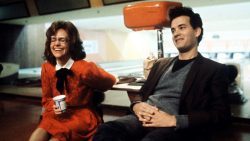Posted March 1, 2022
Curator Notes: Compartment No. 6
Compartment No. 6 opens Friday, April 1 at the JBFC. Get the inside scoop in this note from JBFC Preview Club Film Curator Karen Goodman before the film’s highly-anticipated opening!
by JBFC Preview Club Film Curator, Karen Goodman
Compartment No. 6 is an internationally co-produced drama (Finland, Estonia, Germany, Russia), co-written and directed by Finnish filmmaker Juho Kuosmanen. This is Kuosmanen’s second feature film, which premiered at Cannes 2021 and won the Grand Prix award (the festival’s second prize) together with Asghar Farhadi’s A Hero, as well as the Special Mention Prize of the Ecumenical Jury. It was selected as the Finnish entry for the Best International Feature Film at the 94th Academy Awards, and became one of the 15 “shortlisted” films along with the Norwegian feature Worst Person in the World (which took a place among the final nominees.)
Filmmaker Juho Kuosmanen is also an actor, and has directed operas and experimental films. His short film The Painting Sellers won the first prize in Cinéfondation at the Cannes Film Festival in 2010, and his first feature film, The Happiest Day in the Life of Olli Mäki, was screened in the Un Certain Regard section at the 2016 Cannes Film Festival, where it won the top prize. Compartment No. 6 received the FIPRESCI Award from the International Federation of Film Critics for “its compelling blend of epic road movie and melodrama, while still retaining an intimate scale; its delicate character work that goes beyond appearances; and its commitment to controversial and unexpected choices.”
Adaptation and Human Connection
Kuosmanen had thought about adapting the book Compartment No.6 by Finnish author Rosa Liksom since it was published in 2011. The book had already been translated into Estonian and Russian, and Kuosmanen spent about eight years ruminating about an adaptation before finally co-writing the screenplay with Estonian collaborators Andris Feldmanis and Livia Ulman. Kuosmanen shares that it was “a dream come true, my dream to make a film in a train in Russia,” and that he was largely intrigued by the human connection between these two very different characters.
The film has often been compared to Linklater’s Before Sunrise; however Kuosmanen points out that in contrast he wanted to avoid the idea of a pre-conceived romantic love story, and that it was a challenge to keep the film focused on more than the ‘burden of romantic love’. On the set there was more of a sense of the characters having ‘a teenage brother and sister connection,’ which is what he was looking for in his adaptation. He wanted the focus to be more on the level of a connection of soulmates, one which transcends romantic love or sexual roles. By the end of the train ride, these two travellers have already formed a strong bond, and Kuosmanen was keen to include a scene where they are “no longer afraid of each other…two children playing with the snow is like the demonstration of an almost childlike freedom, free from any expectation or the weight of their roles in life. Ultimately, they are more similar than different from each other.” Both are running towards and presumably away from something, which was alluded to in the movie’s party scene during the quotation game, with an observation that when you’re running away, it doesn’t matter where you’re running to as much as it matters where you’re running from.
Character Development and Casting
Kuosmanen explains that the characters are just two human beings who feel a strong connection, and are not defined by their nationality, gender, or sexuality. When asked if perhaps Ljoha’s character is gay, Kuosmanen explains: “That was something we thought while writing the script, then we decided to keep it open…Because the whole idea of sexuality is not black and white. I don’t even know if she was a lesbian or bisexual. Our aim was to really see through these cultural identities, which in a way genders are as well, and at some point sexuality, too.”
Finnish actor Seidi Haarla received the Best Acting Award in Sweden for her role as Laura in Compartment No. 6, her first starring role in a feature film. The jury wrote, “The winner of the best acting award literally vibrated out of the screen and into our hearts, creating an intimate performance that takes us on a journey of identity, love and belonging. With great courage conveying what it means to be lost within ourselves, but at the same time staying fearless and curious of the world.” Laura’s part was cast first, a year and a half before filming, and she spent a lot of time with Kuosmanen developing the script and getting to know the character. The Russian actor Yuri Borisov was cast later, and although the male character was originally much older, Kuosmanen felt that because their chemistry is the core of the film, he was the perfect choice to make this story with: “The whole film happens in the way they see each other differently through the film.”
Mise en Scène and Technology
There is an undeniably strong sense of place in the film, created by the choice to shoot in moving railroad cars rather than on soundstages, which allowed for claustrophobic spaces and jerky motions to help create “a threatening intimacy from their first meeting.” Kuosmanen explains that the train is a public space, which belongs to no one and everyone, with a shabby second-class sleeping car and an egalitarian bunk policy, which brings these two characters together. The filmmaker chose to advance the time frame in the original book by a decade, and created a period piece set a few years after the collapse of the Soviet Union in the late 1990s. In the book they are traveling to Mongolia; Kuosmanen chose instead to make Laura’s destination the Kanozero petroglyphs, which weren’t discovered until 1997, and he situated the story during the waning days of the Yeltsin regime, which was a turbulent era in Russia.
Kuosmanen explains that setting the film in its original time period would have required building Soviet scenery, but in the later decade they could basically show things as they look today. He explains that the book deals with the Soviet Union as “a state of mind,” rather than a country, so he wanted to avoid a “geographical-political frame,” which would have been distracting: “what I want you to look at are these two human beings, without any topical comments on time or place.” As inspiration for his films, Kuosmanen pursues stories based on ‘’a love for real people, who are clumsy and imperfect…no opinions, no message, but this is the way I see the world and how I show it.”
In emotional terms the film reaches its climax after Laura loses her camera with all her images of Moscow, and in this way she is forced to move on. It was important for Kuosmanen to set the story in a pre-digital era, when loneliness could not be cured with a cell phone or a screen, “The film is a memory of the world as it was.” The film was shot in 35mm, which helped to define the texture of the period in the 90s. The DP is also a documentary filmmaker, and the confines of the train cabins required flexibility, using small film cassettes and radio microphones planted all over the car instead of a boom.
The soundtrack is also used to set a period tone, in which Desireless’ 1986 euro-pop hit “Voyage Voyage” is thematic, and Roxy Music’s “Love Is the Drug” in the opening party scene underscores Laura’s sense of isolation among this urban, sophisticated crowd. Kuosmanen explains that her faltering self image and desire to be accepted as an intellectual get in her way, and later when she meets Ljoha, she can see parts of herself and is able to relax. The ‘stealing of the camera’ is also meant to emphasize that everything changes, and that accepting loss and change is a big part of life and can be liberating. With those images gone, Laura is able to leave her memories behind and live in the moment.
Production and Pandemic Challenges
Kuosmanen went for the adventure of the filmmaking process rather than staying with safe choices, and because his style is naturalistic he didn’t want the actors to work in front of a green screen. They rented two older train cabins on a railroad circuit in St. Petersburg—one for the crew and one for the actors—which attached and detached from the actual moving train. The only modification to the compartment was that they removed the toilet for additional filming space. The exteriors were real, and they shot the scenes that included exterior northern landscapes near the arctic on location later in the schedule.
However, shooting on a train presented unique difficulties for the production, compounding the headaches created by Russian authorities and extensive permit requirements. Filming was slow, and each change required emptying everyone from the car. Kuosmanen couldn’t watch the performances next to the camera as usual, and shared that watching on a monitor from the next compartment wasn’t ideal, because you can’t feel the atmosphere or read the emotional content of the performances in the same way. Regardless, he was happy with the choice because of the authenticity it brought, including the unique sounds of the train, which he likens to an orchestra that builds throughout the scenes.
Most of the film was locked before Covid restrictions began, but they couldn’t shoot some planned scenes in Moscow because the Finnish borders were already closed. The last scene they shot during the pandemic in Russia was the party in Moscow, which opens the film. Instead of casting the scene with actors, the producers invited friends to a party in St. Petersburg and shot it using practically no lights. Those actors from outside of Russia barely made it out of the country just before the borders closed.
A snowstorm surprised them while shooting the final scenes of the film, and blew their catering tent out to sea. Despite the hardships, they felt that it was such an amazing visual moment that the entire crew rallied to finish in these conditions. In an interview, Kuosmanen discusses the reference to the film Titanic (1997), in which he explains that the quote was intended to place the film in a particular time frame, but also “to remind us that one of the themes of the film is the acceptance of death, of the fact that you only live moment by moment, and that nothing lasts forever…It is sad but at the same time it is very beautiful.”
Additional Reading:
- Watch Juho Kuosmanen’s interview in English (including fantastic clips) at Cinema Without Borders
- Read a fabulous interview with details about character development, production design, acting challenges and more. JUHO KUOSMANEN & SEIDI HAARLA ON COMPARTMENT NO. 6 in Curzon
Want to stay up to date on what’s happening at the JBFC? Make sure to sign up for our ebulletin HERE.



